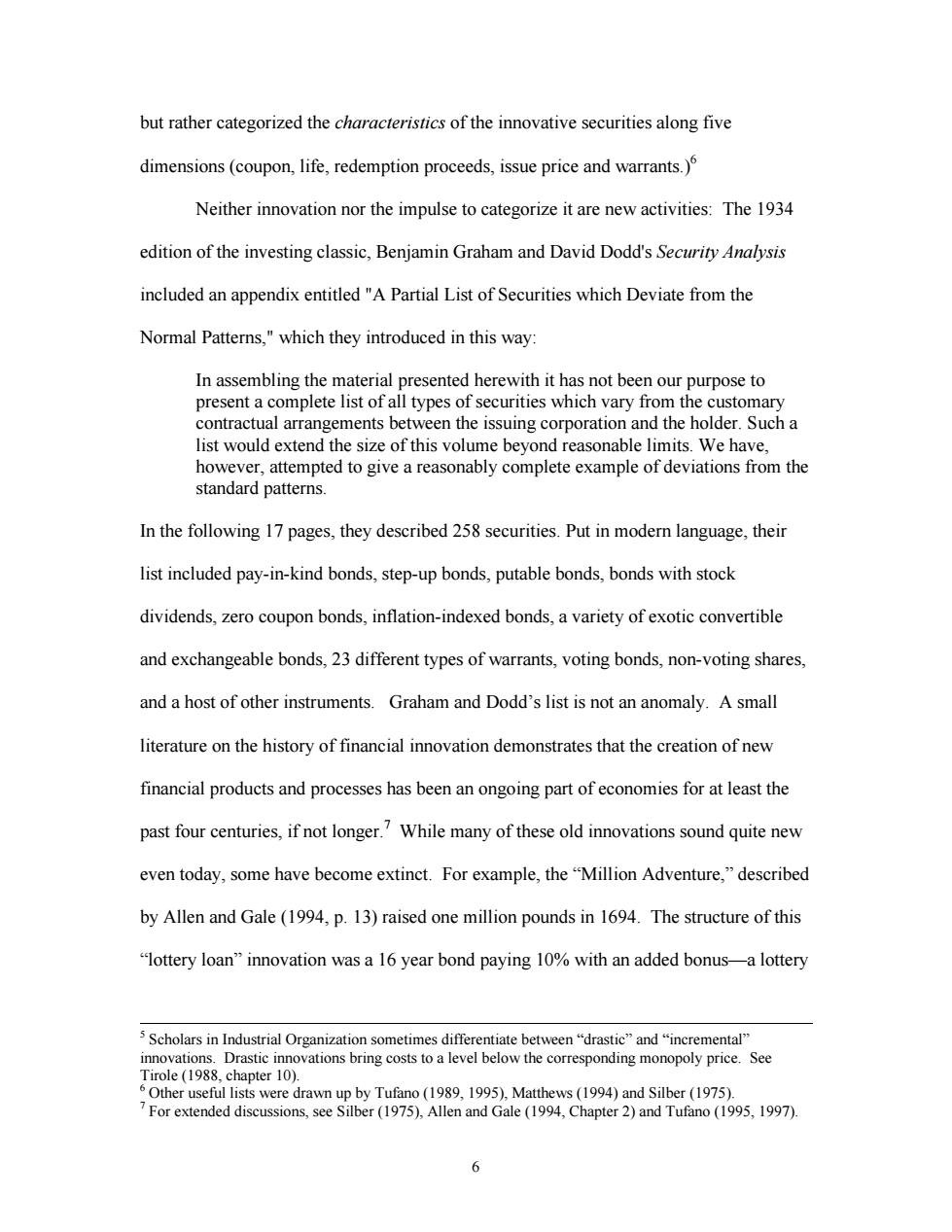
but rather categorized the characteristics of the innovative securities along five dimensions(coupon,life,redemption proceeds,issue price and warrants.) Neither innovation nor the impulse to categorize it are new activities:The 1934 edition of the investing classic,Benjamin Graham and David Dodd's Security Analysis included an appendix entitled "A Partial List of Securities which Deviate from the Normal Patterns,"which they introduced in this way: In assembling the material presented herewith it has not been our purpose to present a complete list of all types of securities which vary from the customary contractual arrangements between the issuing corporation and the holder.Such a list would extend the size of this volume beyond reasonable limits.We have, however,attempted to give a reasonably complete example of deviations from the standard patterns. In the following 17 pages,they described 258 securities.Put in modern language,their list included pay-in-kind bonds,step-up bonds,putable bonds,bonds with stock dividends,zero coupon bonds,inflation-indexed bonds,a variety of exotic convertible and exchangeable bonds,23 different types of warrants,voting bonds,non-voting shares, and a host of other instruments.Graham and Dodd's list is not an anomaly.A small literature on the history of financial innovation demonstrates that the creation of new financial products and processes has been an ongoing part of economies for at least the past four centuries,if not longer.?While many of these old innovations sound quite new even today,some have become extinct.For example,the "Million Adventure,"described by Allen and Gale (1994,p.13)raised one million pounds in 1694.The structure of this "lottery loan"innovation was a 16 year bond paying 10%with an added bonus-a lottery 5 Scholars in Industrial Organization sometimes differentiate between"drastic"and"incremental" innovations.Drastic innovations bring costs to a level below the corresponding monopoly price.See Tirole(1988,chapter 10). Other useful lists were drawn up by Tufano(1989,1995),Matthews (1994)and Silber(1975). 7For extended discussions,see Silber(1975),Allen and Gale(194,Chapter 2)and Tufano(1995,1997). 6
6 but rather categorized the characteristics of the innovative securities along five dimensions (coupon, life, redemption proceeds, issue price and warrants.)6 Neither innovation nor the impulse to categorize it are new activities: The 1934 edition of the investing classic, Benjamin Graham and David Dodd's Security Analysis included an appendix entitled "A Partial List of Securities which Deviate from the Normal Patterns," which they introduced in this way: In assembling the material presented herewith it has not been our purpose to present a complete list of all types of securities which vary from the customary contractual arrangements between the issuing corporation and the holder. Such a list would extend the size of this volume beyond reasonable limits. We have, however, attempted to give a reasonably complete example of deviations from the standard patterns. In the following 17 pages, they described 258 securities. Put in modern language, their list included pay-in-kind bonds, step-up bonds, putable bonds, bonds with stock dividends, zero coupon bonds, inflation-indexed bonds, a variety of exotic convertible and exchangeable bonds, 23 different types of warrants, voting bonds, non-voting shares, and a host of other instruments. Graham and Dodd’s list is not an anomaly. A small literature on the history of financial innovation demonstrates that the creation of new financial products and processes has been an ongoing part of economies for at least the past four centuries, if not longer.7 While many of these old innovations sound quite new even today, some have become extinct. For example, the “Million Adventure,” described by Allen and Gale (1994, p. 13) raised one million pounds in 1694. The structure of this “lottery loan” innovation was a 16 year bond paying 10% with an added bonus—a lottery 5 Scholars in Industrial Organization sometimes differentiate between “drastic” and “incremental” innovations. Drastic innovations bring costs to a level below the corresponding monopoly price. See Tirole (1988, chapter 10). 6 Other useful lists were drawn up by Tufano (1989, 1995), Matthews (1994) and Silber (1975). 7 For extended discussions, see Silber (1975), Allen and Gale (1994, Chapter 2) and Tufano (1995, 1997)
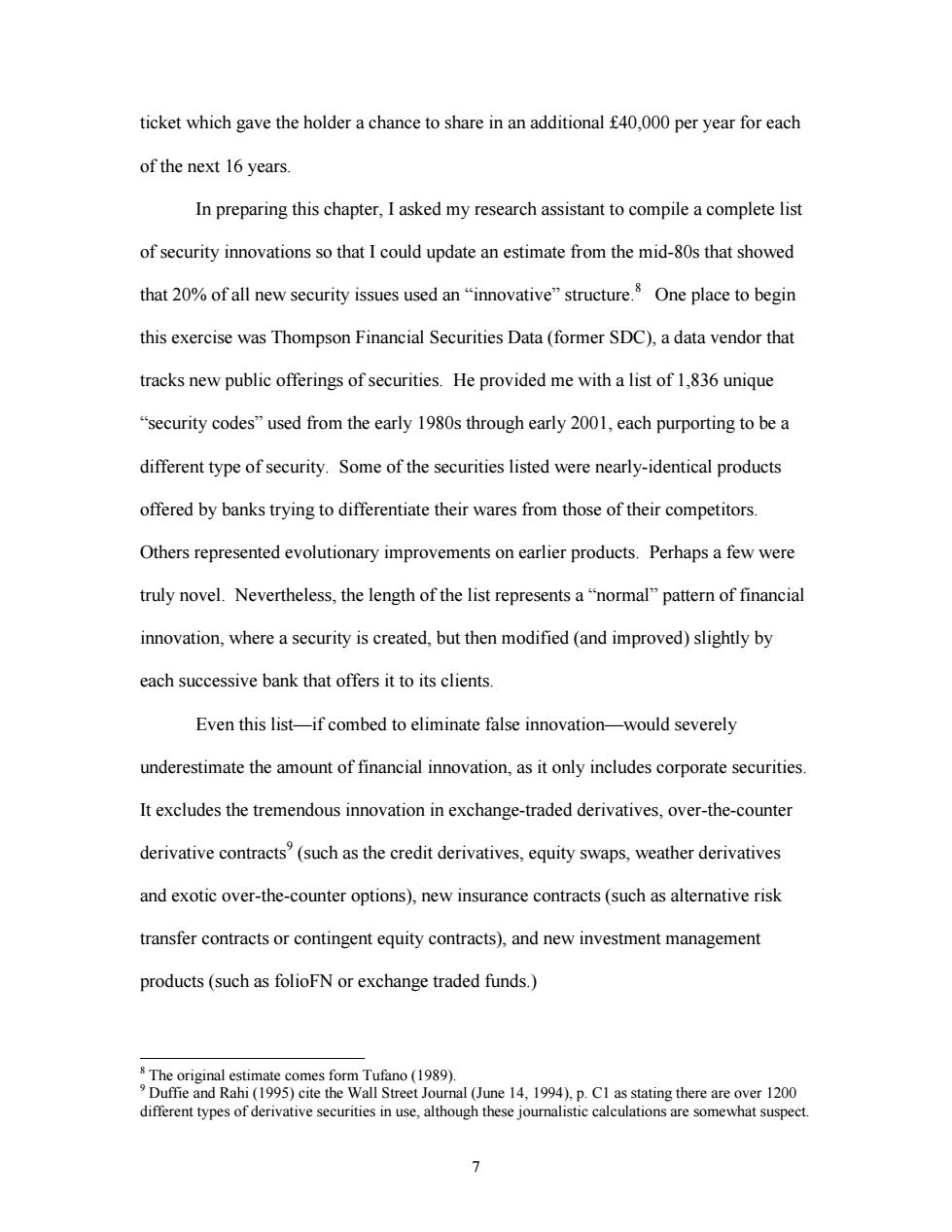
ticket which gave the holder a chance to share in an additional f40,000 per year for each of the next 16 years. In preparing this chapter,I asked my research assistant to compile a complete list of security innovations so that I could update an estimate from the mid-80s that showed that 20%of all new security issues used an"innovative"structure.One place to begin this exercise was Thompson Financial Securities Data(former SDC),a data vendor that tracks new public offerings of securities.He provided me with a list of 1,836 unique security codes"used from the early 1980s through early 2001,each purporting to be a different type of security.Some of the securities listed were nearly-identical products offered by banks trying to differentiate their wares from those of their competitors. Others represented evolutionary improvements on earlier products.Perhaps a few were truly novel.Nevertheless,the length of the list represents a"normal"pattern of financial innovation,where a security is created,but then modified (and improved)slightly by each successive bank that offers it to its clients. Even this list-if combed to eliminate false innovation-would severely underestimate the amount of financial innovation,as it only includes corporate securities. It excludes the tremendous innovation in exchange-traded derivatives,over-the-counter derivative contracts'(such as the credit derivatives,equity swaps,weather derivatives and exotic over-the-counter options),new insurance contracts(such as alternative risk transfer contracts or contingent equity contracts),and new investment management products(such as folioFN or exchange traded funds.) s The original estimate comes form Tufano(1989) Duffie and Rahi (1995)cite the Wall Street Journal (June 14,1994),p.C1 as stating there are over 1200 different types of derivative securities in use,although these journalistic calculations are somewhat suspect
7 ticket which gave the holder a chance to share in an additional £40,000 per year for each of the next 16 years. In preparing this chapter, I asked my research assistant to compile a complete list of security innovations so that I could update an estimate from the mid-80s that showed that 20% of all new security issues used an “innovative” structure.8 One place to begin this exercise was Thompson Financial Securities Data (former SDC), a data vendor that tracks new public offerings of securities. He provided me with a list of 1,836 unique “security codes” used from the early 1980s through early 2001, each purporting to be a different type of security. Some of the securities listed were nearly-identical products offered by banks trying to differentiate their wares from those of their competitors. Others represented evolutionary improvements on earlier products. Perhaps a few were truly novel. Nevertheless, the length of the list represents a “normal” pattern of financial innovation, where a security is created, but then modified (and improved) slightly by each successive bank that offers it to its clients. Even this list—if combed to eliminate false innovation—would severely underestimate the amount of financial innovation, as it only includes corporate securities. It excludes the tremendous innovation in exchange-traded derivatives, over-the-counter derivative contracts9 (such as the credit derivatives, equity swaps, weather derivatives and exotic over-the-counter options), new insurance contracts (such as alternative risk transfer contracts or contingent equity contracts), and new investment management products (such as folioFN or exchange traded funds.) 8 The original estimate comes form Tufano (1989). 9 Duffie and Rahi (1995) cite the Wall Street Journal (June 14, 1994), p. C1 as stating there are over 1200 different types of derivative securities in use, although these journalistic calculations are somewhat suspect
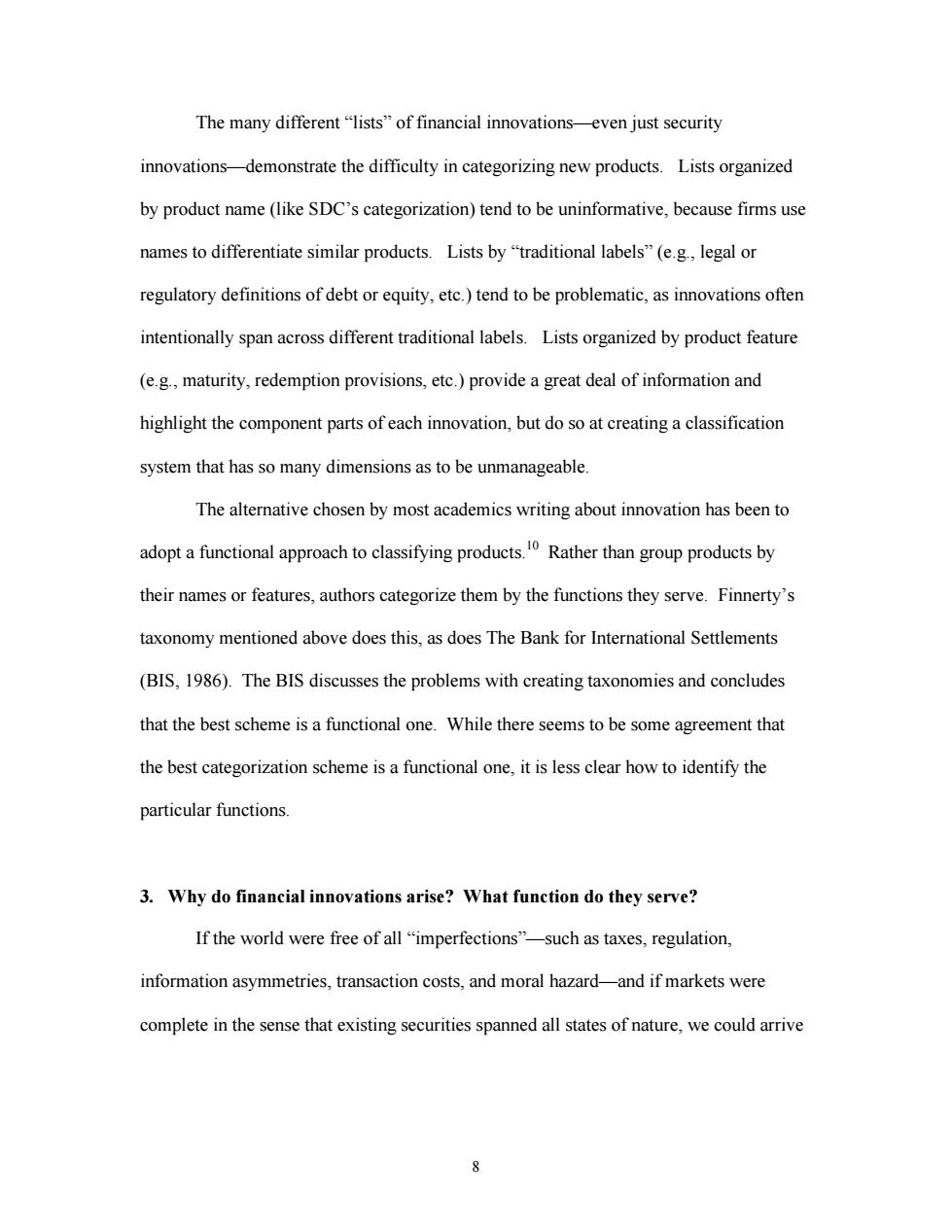
The many different"lists"of financial innovations-even just security innovations-demonstrate the difficulty in categorizing new products.Lists organized by product name(like SDC's categorization)tend to be uninformative,because firms use names to differentiate similar products.Lists by"traditional labels"(e.g.,legal or regulatory definitions of debt or equity,etc.)tend to be problematic,as innovations often intentionally span across different traditional labels.Lists organized by product feature (e.g.,maturity,redemption provisions,etc.)provide a great deal of information and highlight the component parts of each innovation,but do so at creating a classification system that has so many dimensions as to be unmanageable. The alternative chosen by most academics writing about innovation has been to adopt a functional approach to classifying products.Rather than group products by their names or features,authors categorize them by the functions they serve.Finnerty's taxonomy mentioned above does this,as does The Bank for International Settlements (BIS,1986).The BIS discusses the problems with creating taxonomies and concludes that the best scheme is a functional one.While there seems to be some agreement that the best categorization scheme is a functional one,it is less clear how to identify the particular functions. 3.Why do financial innovations arise?What function do they serve? If the world were free of all "imperfections"-such as taxes,regulation, information asymmetries,transaction costs,and moral hazard-and if markets were complete in the sense that existing securities spanned all states of nature,we could arrive 8
8 The many different “lists” of financial innovations—even just security innovations—demonstrate the difficulty in categorizing new products. Lists organized by product name (like SDC’s categorization) tend to be uninformative, because firms use names to differentiate similar products. Lists by “traditional labels” (e.g., legal or regulatory definitions of debt or equity, etc.) tend to be problematic, as innovations often intentionally span across different traditional labels. Lists organized by product feature (e.g., maturity, redemption provisions, etc.) provide a great deal of information and highlight the component parts of each innovation, but do so at creating a classification system that has so many dimensions as to be unmanageable. The alternative chosen by most academics writing about innovation has been to adopt a functional approach to classifying products.10 Rather than group products by their names or features, authors categorize them by the functions they serve. Finnerty’s taxonomy mentioned above does this, as does The Bank for International Settlements (BIS, 1986). The BIS discusses the problems with creating taxonomies and concludes that the best scheme is a functional one. While there seems to be some agreement that the best categorization scheme is a functional one, it is less clear how to identify the particular functions. 3. Why do financial innovations arise? What function do they serve? If the world were free of all “imperfections”—such as taxes, regulation, information asymmetries, transaction costs, and moral hazard—and if markets were complete in the sense that existing securities spanned all states of nature, we could arrive
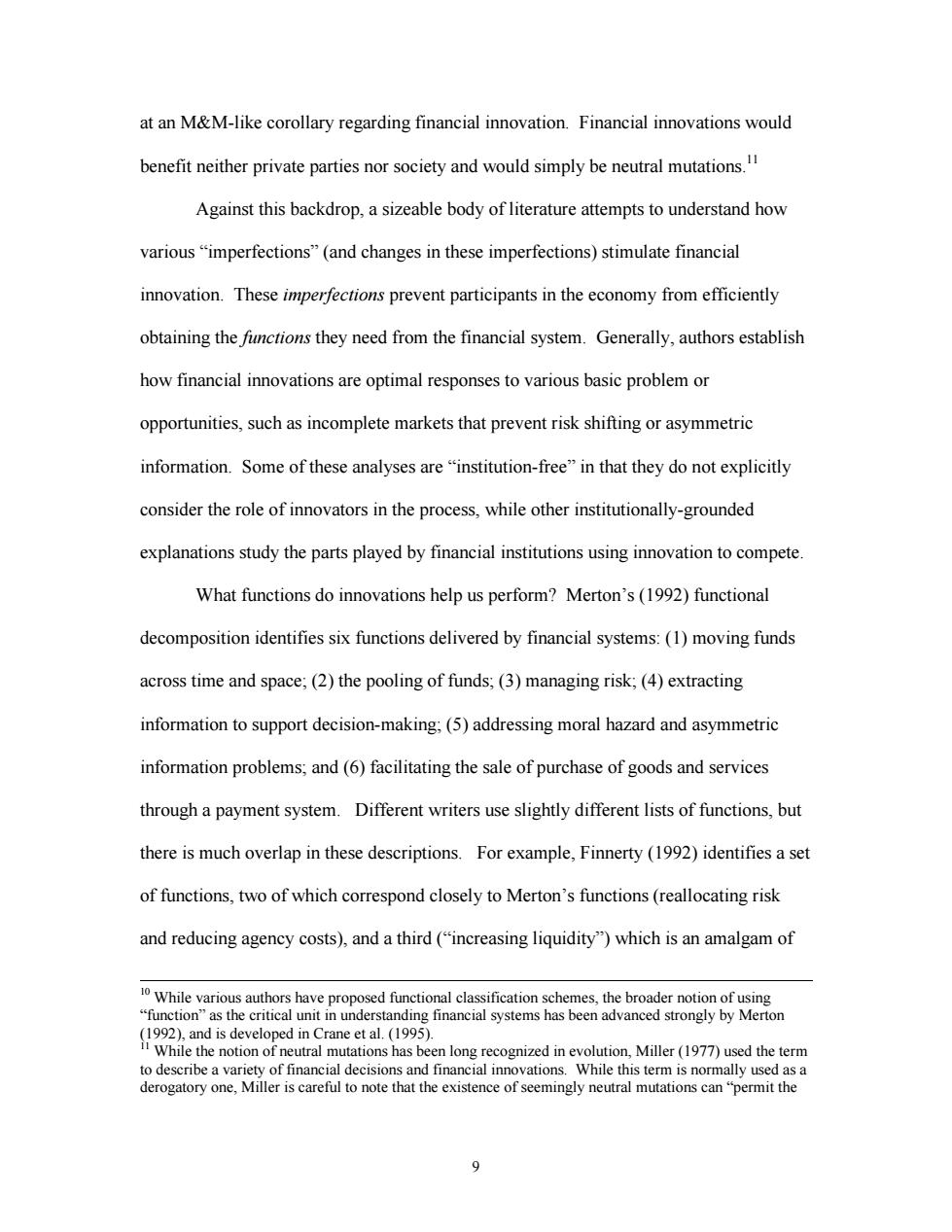
at an M&M-like corollary regarding financial innovation.Financial innovations would benefit neither private parties nor society and would simply be neutral mutations Against this backdrop,a sizeable body of literature attempts to understand how various"imperfections"(and changes in these imperfections)stimulate financial innovation.These imperfections prevent participants in the economy from efficiently obtaining the functions they need from the financial system.Generally,authors establish how financial innovations are optimal responses to various basic problem or opportunities,such as incomplete markets that prevent risk shifting or asymmetric information.Some of these analyses are"institution-free"in that they do not explicitly consider the role of innovators in the process,while other institutionally-grounded explanations study the parts played by financial institutions using innovation to compete What functions do innovations help us perform?Merton's(1992)functional decomposition identifies six functions delivered by financial systems:(1)moving funds across time and space;(2)the pooling of funds;(3)managing risk;(4)extracting information to support decision-making;(5)addressing moral hazard and asymmetric information problems;and(6)facilitating the sale of purchase of goods and services through a payment system.Different writers use slightly different lists of functions,but there is much overlap in these descriptions.For example,Finnerty (1992)identifies a set of functions,two of which correspond closely to Merton's functions(reallocating risk and reducing agency costs),and a third("increasing liquidity")which is an amalgam of 1 While various authors have proposed functional classification schemes,the broader notion of using "function"as the critical unit in understanding financial systems has been advanced strongly by Merton (1992),and is developed in Crane et al.(1995). While the notion of neutral mutations has been long recognized in evolution,Miller(1977)used the term to describe a variety of financial decisions and financial innovations.While this term is normally used as a derogatory one,Miller is careful to note that the existence of seemingly neutral mutations can"permit the 9
9 at an M&M-like corollary regarding financial innovation. Financial innovations would benefit neither private parties nor society and would simply be neutral mutations.11 Against this backdrop, a sizeable body of literature attempts to understand how various “imperfections” (and changes in these imperfections) stimulate financial innovation. These imperfections prevent participants in the economy from efficiently obtaining the functions they need from the financial system. Generally, authors establish how financial innovations are optimal responses to various basic problem or opportunities, such as incomplete markets that prevent risk shifting or asymmetric information. Some of these analyses are “institution-free” in that they do not explicitly consider the role of innovators in the process, while other institutionally-grounded explanations study the parts played by financial institutions using innovation to compete. What functions do innovations help us perform? Merton’s (1992) functional decomposition identifies six functions delivered by financial systems: (1) moving funds across time and space; (2) the pooling of funds; (3) managing risk; (4) extracting information to support decision-making; (5) addressing moral hazard and asymmetric information problems; and (6) facilitating the sale of purchase of goods and services through a payment system. Different writers use slightly different lists of functions, but there is much overlap in these descriptions. For example, Finnerty (1992) identifies a set of functions, two of which correspond closely to Merton’s functions (reallocating risk and reducing agency costs), and a third (“increasing liquidity”) which is an amalgam of 10 While various authors have proposed functional classification schemes, the broader notion of using “function” as the critical unit in understanding financial systems has been advanced strongly by Merton (1992), and is developed in Crane et al. (1995). 11 While the notion of neutral mutations has been long recognized in evolution, Miller (1977) used the term to describe a variety of financial decisions and financial innovations. While this term is normally used as a derogatory one, Miller is careful to note that the existence of seemingly neutral mutations can “permit the
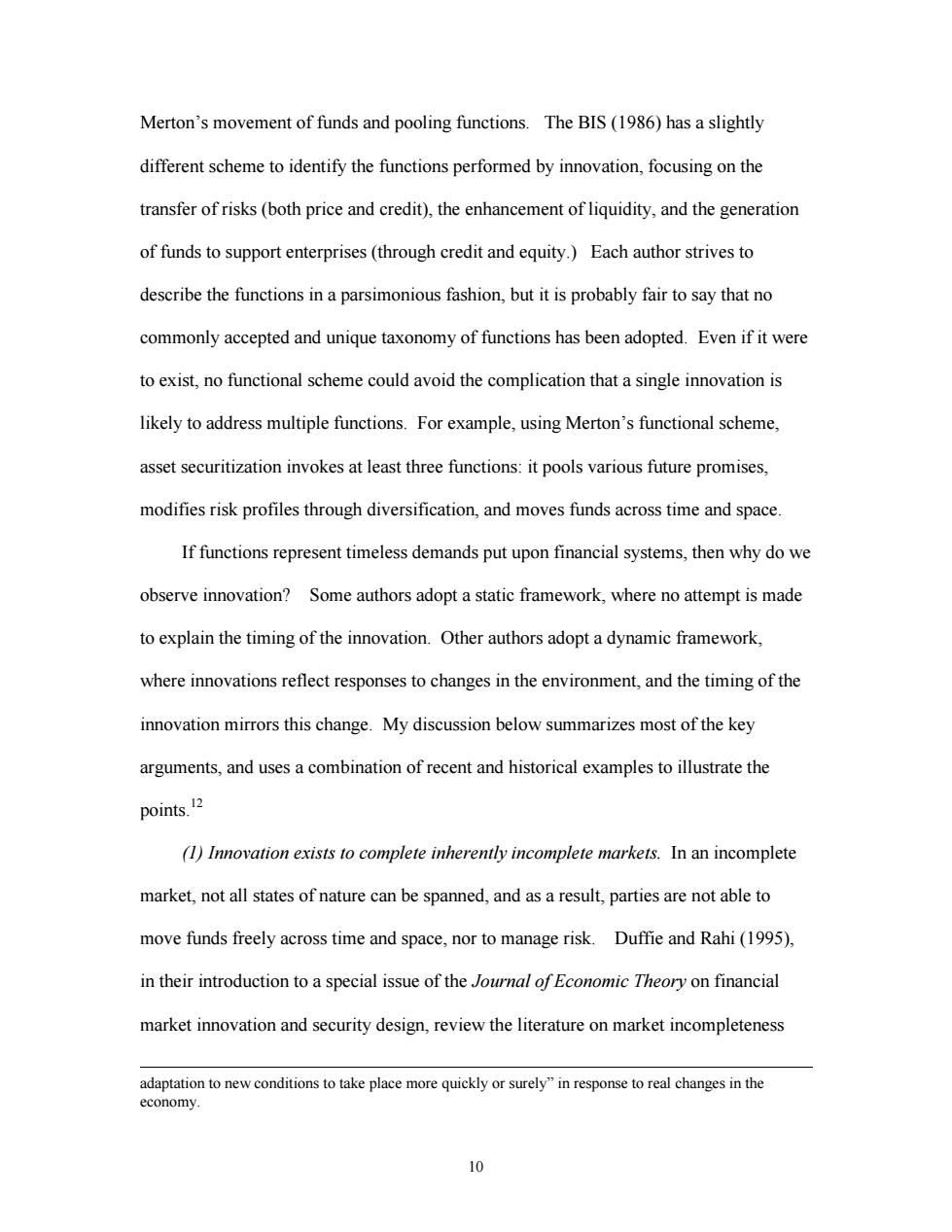
Merton's movement of funds and pooling functions.The BIS(1986)has a slightly different scheme to identify the functions performed by innovation,focusing on the transfer of risks(both price and credit),the enhancement of liquidity,and the generation of funds to support enterprises (through credit and equity.)Each author strives to describe the functions in a parsimonious fashion,but it is probably fair to say that no commonly accepted and unique taxonomy of functions has been adopted.Even if it were to exist,no functional scheme could avoid the complication that a single innovation is likely to address multiple functions.For example,using Merton's functional scheme, asset securitization invokes at least three functions:it pools various future promises, modifies risk profiles through diversification,and moves funds across time and space. If functions represent timeless demands put upon financial systems,then why do we observe innovation?Some authors adopt a static framework,where no attempt is made to explain the timing of the innovation.Other authors adopt a dynamic framework, where innovations reflect responses to changes in the environment,and the timing of the innovation mirrors this change.My discussion below summarizes most of the key arguments,and uses a combination of recent and historical examples to illustrate the points.12 (1)Innovation exists to complete inherently incomplete markets.In an incomplete market,not all states of nature can be spanned,and as a result,parties are not able to move funds freely across time and space,nor to manage risk.Duffie and Rahi (1995), in their introduction to a special issue of the Journal of Economic Theory on financial market innovation and security design,review the literature on market incompleteness adaptation to new conditions to take place more quickly or surely"in response to real changes in the economy. 10
10 Merton’s movement of funds and pooling functions. The BIS (1986) has a slightly different scheme to identify the functions performed by innovation, focusing on the transfer of risks (both price and credit), the enhancement of liquidity, and the generation of funds to support enterprises (through credit and equity.) Each author strives to describe the functions in a parsimonious fashion, but it is probably fair to say that no commonly accepted and unique taxonomy of functions has been adopted. Even if it were to exist, no functional scheme could avoid the complication that a single innovation is likely to address multiple functions. For example, using Merton’s functional scheme, asset securitization invokes at least three functions: it pools various future promises, modifies risk profiles through diversification, and moves funds across time and space. If functions represent timeless demands put upon financial systems, then why do we observe innovation? Some authors adopt a static framework, where no attempt is made to explain the timing of the innovation. Other authors adopt a dynamic framework, where innovations reflect responses to changes in the environment, and the timing of the innovation mirrors this change. My discussion below summarizes most of the key arguments, and uses a combination of recent and historical examples to illustrate the points.12 (1) Innovation exists to complete inherently incomplete markets. In an incomplete market, not all states of nature can be spanned, and as a result, parties are not able to move funds freely across time and space, nor to manage risk. Duffie and Rahi (1995), in their introduction to a special issue of the Journal of Economic Theory on financial market innovation and security design, review the literature on market incompleteness adaptation to new conditions to take place more quickly or surely” in response to real changes in the economy